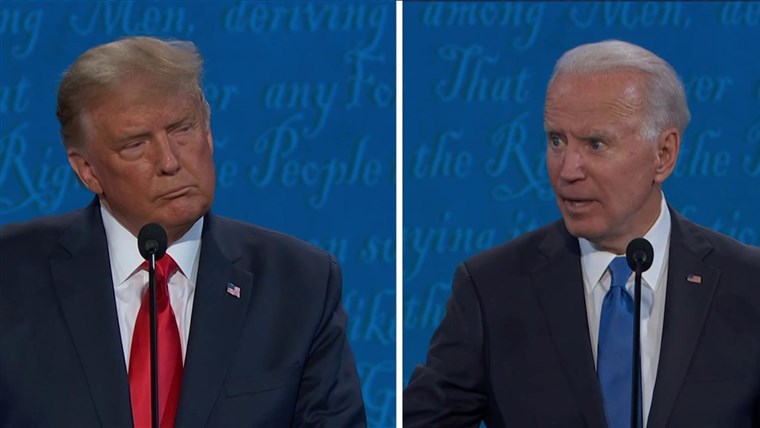The minimum wage in the United States hasn’t budged in 11 years. Whether it should was a hotly contested question during Thursday’s final presidential debate.
President Donald Trump asserted that increasing the minimum wage would crush small businesses, many of which are already struggling as a result of the pandemic, arguing that the decision should be left to the states. Democratic nominee Joe Biden repeated his campaign pledge to raise the minimum wage from its current $7.25 to $15.
Establishing a $15 wage floor has been a long-term goal of union-backed advocacy groups, which began putting pressure on big companies like McDonald’s and Walmart to pay workers $15 an hour in 2012. The Democratic Party made a $15 minimum wage part of its platform ahead of the 2016 election season. A handful of states with high costs of living — California, Connecticut, Illinois, Maryland, Massachusetts, New Jersey and New York — as well as some cities have adopted laws that will raise the minimum wage to $15 over time, and 29 states as well as the District of Columbia have minimum wages higher than the federal one.
The issue clearly resonates with voters: “Wages” was the most-searched topic in 44 states during the debate (the top search in the remaining six states was “unemployment”). Surveys indicate, though, that Trump’s view is out of step with that of most Americans: Two-thirds want to see a $15 minimum wage, according to the Pew Research Center.
Business groups have argued that raising the minimum wage forces business owners to fire workers, a claim echoed by Trump in the debate. The reality is more complex: The evidence of job loss is inconsistent, and the benefits are accrued by some of the country’s most vulnerable populations.
In terms of reducing income and wealth disparities, a rising minimum wage is a good thing. “The benefits in terms of reducing inequality — getting money into people’s pockets, stimulating the market — are very well proven,” said Till von Wachter, professor of economics and director of the California Policy Lab at the University of California, Los Angeles.
“The best evidence is that judiciously set minimum wages make a lot of sense. They raise earnings, reduce individual and family poverty, and have no measurable negative effects on employment,” said David Autor, an economics professor at MIT and co-chair of the MIT Task Force on the Work of the Future.
A report last year by the Congressional Budget Office found that a $15 minimum wage would increase the income of 27 million workers, 17 million of whom currently earn below that amount with the remaining 10 million earning just over $15 an hour, but all of whom would see their wages rise due to what economists call the “spillover effect.”
When adjusted for inflation, today’s minimum wage gives workers far less buying power than it once did. Since peaking 52 years ago, purchasing power of the minimum wage has fallen by 31 percent — the equivalent of $6,800 for someone working full-time at minimum wage for a year.
“The real value of the federal U.S. minimum wage is at a historic low,” Autor said. “I’d be happy to see something like $12 or $13, indexed to inflation so it doesn’t again sink to irrelevance within 10 years.”
A $15 wage would lift 1.3 million households above the poverty line — but the flip side could be fewer jobs. The CBO estimated a median loss of 1.3 million jobs, although it also acknowledged considerable ambiguity with that figure. “Findings in the research literature about how changes in the federal minimum wage affect employment vary widely,” the agency said.
A 10 percent increase in base pay is associated with a 1.5-percentage-point increase in the likelihood that workers will remain with their current employer, which can translate to significant cost savings for companies.
Given the sweeping societal impact a higher minimum wage would have on the lives of the poorest Americans, von Wachter said policymakers should deem this potential an acceptable risk. “We accept these small efficiency costs because we think it’s valuable to provide that redistribution. We accept a trade-off between costs and benefits,” he said, adding that most of the studies have yielded no evidence of higher minimum wages triggering job losses.
Some research has even found the opposite — that is, a higher minimum wage can increase employment in some situations. When studying employment practices of big chain stores, von Wachter found that raising the minimum wage had the most positive effect in labor markets dominated by just a few large employers.
Download the NBC News app for breaking news and politics
Other data suggests that higher pay improves worker satisfaction and leads to lower turnover, which can help mitigate employers’ higher payroll costs. According to Glassdoor, a 10 percent increase in base pay is associated with a 1.5-percentage-point increase in the likelihood that workers will remain with their current employer, which can translate to significant cost savings for companies. Replacing a low-wage worker costs about 16 percent of that worker’s annual salary.
A minimum wage that hasn’t risen since 2009 will only become increasingly unsustainable for the people relying on it, experts say. “There’s a lot of headroom to raise it [and] workers would benefit,” Autor said. “We can afford to do better.”

